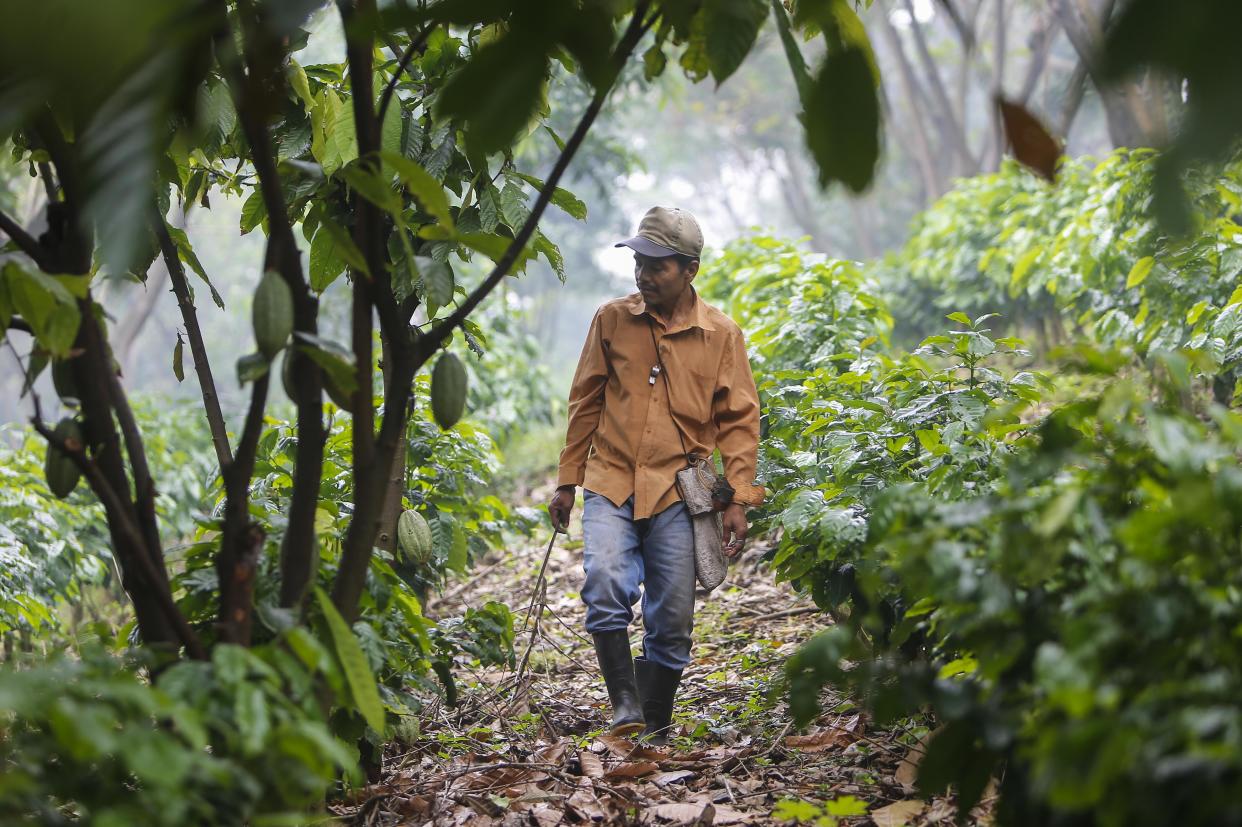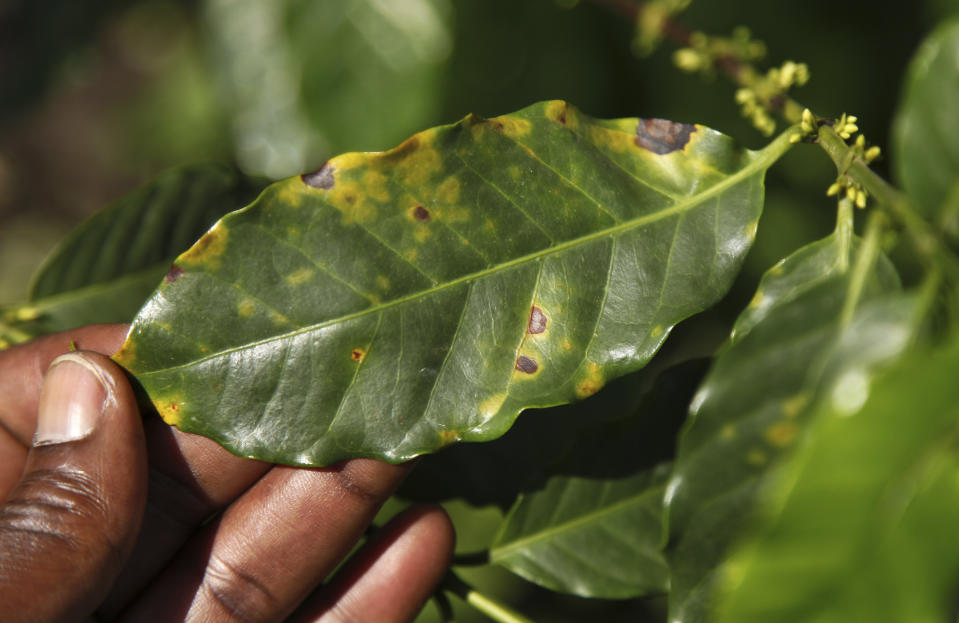Coffee disease could put your daily 'Cup of Joe' in jeopardy

Many people can’t imagine starting their day without at least one cup of coffee, but now a University of Guelph professor has published findings of a 16 year project, indicating that our morning cup of coffee could be in jeopardy - or at least could be more costly.
“People have said since this story came out, do I need to stockpile coffee,” Stuart McCook told Yahoo Canada. “No, I don’t think you need to stockpile coffee but I think we have to understand that the global coffee industry rests, a lot of it, on very, very fragile ecological and economic foundation.”
“Unless, not just the farmers themselves but the international community, start to take steps to strengthen those ecological and economic foundations, the global coffee industry could be in for some big challenges.”
In his book titled “Coffee is Not Forever: A Global History of the Coffee Leaf Rust,” McCook details his study of coffee leaf rust and how it has impacted the industry that so many people around the globe rely on.
“Things can happen quickly,” McCook said. “If you get a perfect storm of economic and ecological challenges, what you can see is farmers just deciding that it’s not worth cultivating coffee anymore and leaving.”
What is coffee leaf rust?
Coffee leaf rust is a disease that causes coffee trees to lose all or some of its leaves, which leads to the plant not developing properly. In the current season, it causes the the fruit to develop badly, or sometimes not develop at all. The coffee’s taste can also be impacted, which is a particular concern in markets that produce specialty or high-end coffees.
“An impact on the taste can be very damaging to the profitability of the farm,” McCook said.
This rust also results in what plant pathologists call secondary losses.
“It prevents the plant tissue, particularly the branches, from developing as they normally would, which has an impact on the following year’s harvest,” McCook added.
Coffee leaf rust was first detected in 1869, which broke out in Ceylon (modern day Sri Lanka). By the late 1800s, coffee planters in the region switched from coffee to tea, the most viable option for them.
What causes coffee leaf rust to spread?
According to McCook, the disease is very sensitive rainfall and temperature patterns, and is less likely to occur in high altitude environments, which tend to be cooler and drier areas of the tropics.
“In places where there’s lots of...humid environments, where there’s lots of water droplets on the leaves, that can trigger outbreaks,” McCook said. “Warmer temperatures tend to promote the development of the disease.”
One aspect of his research that was a “real surprise” to him is how climate change has impacted coffee leaf rust. Initially, McCook was told by farmers and scientists that the rust was around, but they knew how to manage it.
“When we think about the impact of climate change, we tend to think about the kind of geophysical stuff,” McCook said. “We think about the rainfall and the temperatures, and those are huge, but there are also these kind of more subtle impacts of climate change, like the change in distribution of diseases.”
“Diseases that...our farmers used to be able to coexist with, that coexistence is becoming, in some cases, quite fragile.”
In 1989, the International Coffee Agreement of the 20th century broke down, where coffee producers agreed to a set of global production quotas, and coffee prices starting to “boom and bust.”
“The other thing that happened was with economic reforms, neoliberal economic reforms in the 1980s and 1990s, a lot of governments in the developing world had to slash public services including, in many places, public services to farmers,” McCook said.
“What happened then was a lot of the smaller, poorer farmers stopped spraying their coffee quite so often and stopped doing the things that they needed to do to keep the rust under control, simply because they couldn’t afford it.”
At this time, farmers didn’t replant coffee trees often enough, meaning coffee farms had older plants, which are also more susceptible to the disease.
The first of the recent outbreaks was in Colombia in 2007, which temporarily reduced coffee production in the country by about a third, according to McCook.
“Another one broke out in Central America, starting in about 2012, and there it reduced the region’s overall production by about 15 per cent, but in some areas it was much, much more devastating than that,” he said.

Is all coffee impacted?
The recent outbreaks of coffee leaf rust in Colombia and Central America hit one of the “heartlands” of specialty coffee production,” McCook explained. There are only a few places in the world that are adequate environments to produce the highest quality coffee - Central America, Peru, Ethiopia, a few places in Indonesia and Kenya.
“A lot of these coffees are based on kind of heirloom varieties of Arabica and the resistant varieties of Arabica...are often cross-bred with Robusta coffee, which is...a different species of coffee but, it’s highly resistant to the rust,” McCook Said. “But it has...a relatively poor cupping quality.”
Cupping is how the quality of coffee is measured. Coffee producers and buyers use the cupping technique to determine if the taste of the product is to their satisfaction. The Specialty Coffee Association of America has established particular protocols for cupping, including water temperature, ratio of coffee to water, grind size and equipment needed for proper cupping.
“The speciality industry has been, I would say, historically quite suspicious of these hybrid coffees but I would say in the last five or ten years or so, the breeders are starting to roll out varieties that kind of have matched some of the classic cultivars in cupping quality.”

How can farmers recover from coffee leaf rust?
In order to recover from the rust, one strategy is to spray or replant the trees with rust resistant varieties, but this can be very costly to farmers. According to McCook it can cost thousands of dollars to replant and many farms don’t have access to those funds.
“Recovery has gone well in places like Honduras, of all places, which has a very well-organized coffee industry, and in Colombia,” McCook said. “In other countries, like Mexico and El Salvador, are the ones that come to mind, the recovery has been much slower.”
Brazil, the world’s single largest coffee producer, has been significantly less impacted by the rust.
“The rust is there but the coffee industry tends to be fairly well organized, and also just the main producing areas still tend to be...relatively high and relatively cool,” McCook said.
He added that farmers and the coffee industry itself are doing all that they can to battle the rust. The specialty coffee industry in particular has recognized that it is a problem.
“World Coffee Research...is developing new rust resilient coffee varieties that are also meant to be economically and socially sustainable,” McCook said. “But then a lot of aid to the farmers often flows through states, and different states have different kinds of commitments to their coffee industries and also, frankly, different states have different abilities to support their farmers.”

